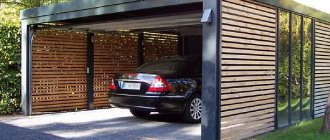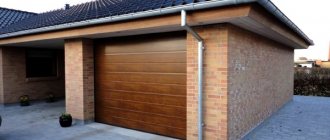Do I need a building permit?
To build a garage on an individual housing construction site, a permit is not required. This is stated in the town planning code, which states that permission is not required in the following cases:
- to build a garage on land provided to an individual not for the purpose of conducting commercial activities or on a site intended for gardening activities (for example, land owned by a dacha cooperative);
- construction of auxiliary structures on the site.
Another thing is that a major garage built on an individual housing construction or private plot plot must be registered, since such a building is also subject to tax, like a house. First, they receive a certificate of ownership of the land on which the building is located, and then the garage itself is legalized. To do this, you need to collect the necessary documents and contact Rosreestr.
If you have an unregistered building on your property, you may have problems selling the property. A garage built in violation of the standards that will be discussed below may be recognized as an unauthorized construction, and by a court decision may be demolished.
Also, permission is not required for the construction of any non-permanent (temporary) structure, that is, a building without a foundation. Such a building is not considered real estate, as it can be moved at any time.
How much do you need to step back from the fence when building a garage?
Similar situations often arise that have simple solutions, including:
- The owner built a garage close to the fence, he doesn’t know what to do. The only correct decision is to fulfill all fire safety training requirements and come to an agreement with the neighbor, documenting the absence of objections.
- What distance should you retreat from the fence when building a garage if the red line is 9 meters away? With such a distance from the property line of the land, the minimum distance between the garage and the fence must, by law, be at least 1 meter.
- If a neighbor built a garage from the fence, without retreating, violating the 1 meter standard, and the side wall is located close to the fence, what should you do? If construction took place without approval, then you need to file an application with the court.
- How much should you step back from your neighbor's house if it is wooden and there is no fence around the property? You should focus on the recommended standards - 15 meters. You can install an iron or brick garage after agreement with your neighbor.
- Settlement in the household after its acquisition occurred later than the time the neighbor built the garage; it turned out that the distances were maintained, and the light did not enter the yard. The courtyard is not a vegetable or garden area. Distances have been maintained, and there is nothing to file claims in court for. In this case, all that remains is to redevelop your site as much as possible.
Every year the country's legislation is improved, and SNiP requirements undergo changes. In this regard, to obtain objective information in each specific case, you should seek advice from practicing specialists. This also applies if difficulties arise when independently preparing a project for a future garage.
How many meters to retreat when erecting an individual building on a site is shown in the video below.
How can you place a garage on an individual housing construction site?
In practice, in many cases, building codes and regulations are turned a blind eye. However, placing a garage in violation of them can lead to dissatisfaction with neighbors and legal proceedings. If you end up being wrong, the structure you built with your labor will have to be demolished. In order not to waste time, effort and money, before building a garage or any other building on the individual housing construction site, you need to familiarize yourself with the SNiPs.
What matters is the distance of the garage from other objects. It also depends on what materials the buildings are made of.
All measurements are taken from the protruding base of the building, and if there is none, then from the wall. If the roof protrudes more than 50 cm, then measure the distance from its projection to the ground.
The following placement standards are prescribed in SNiP 2.07.01-89. According to the norms of individual housing construction, the garage is classified as an outbuilding, therefore it is subject to restrictions associated with them.
- The distance to buildings on the neighboring plot cannot be less than 6 m. It can be reduced by written agreement with the neighbors.
- There should be 10 m between reinforced concrete buildings.
- Between concrete ones - 8 m.
- If the house or garage has wooden floors, then the distance must be increased by 2 m.
- If one building is wooden or made of other flammable materials, then the distance between them should be at least 10 m.
- If both buildings are made of flammable materials, the distance between them should be at least 15 m.
- The distance to the fence separating your property from your neighbor’s must be at least 1 m. This gap is needed for free passage around the building for the purpose of repairs, as well as to prevent water from the roof from flowing onto your neighbors’ property. In this case, the distance to buildings on the neighboring site should also not be less than 6 m. If the buildings are located closer, then it is necessary to count from them.
- If the site faces a side passage, then you need to retreat 3 meters from the edge of the roadway. This rule can be circumvented if the fence is moved deeper into the site rather than placed on the border. Then the situation allows for two interpretations, from the point of view of the law.
- If a central road passes near the site, then 5 m are retreated from its edge.
- According to fire safety standards, a detached permanent garage must be located at least 3 m from a residential building.
- It is advisable to move the garage at least a meter deeper into the site. The gates, when opening, should not block the roadway or interfere with passage and travel along the street; also, a car parked under a canopy should not interfere with passage along the road.
To be on the safe side, add another half meter to these distances.
If nothing has been built on the neighboring site, you are lucky and you can build anywhere in compliance with other standards (distance from the fence, from buildings on your site, from red lines). Construction on a neighboring site, if it starts later, will be carried out taking into account your buildings.
Important! It is the distance to buildings on a neighbor’s property that can cause conflict and litigation. Even one corner that is closer than it should be matters. The rules for the location of buildings relative to each other on your site are advisory in nature.
Standards for private and public garages
Nowadays, a personal garage is not a luxury - it is a necessity. If a person who lives in the private sector can afford to park a vehicle in front of their house or in their yard, and may not be afraid that the car will be stolen, then in places where multi-storey buildings are located, there is no such possibility. And you have to think about a reliable garage for your personal vehicle, taking into account many parameters.
For a garage, the standard dimensions will be the following - 3x6x2.2 m. However, such dimensions are suitable mainly for small domestic cars. Nowadays there are many different brands, so vehicles may not always fit into such a framework. This increases the likelihood of scratches and other defects when the car drives into the garage. It would be best to make the following dimensions - 5x7x3. These dimensions are now considered the most common. In such a room, not only will a vehicle be able to stand freely, but it will also be possible to make shelves and various racks.
SNiP does not indicate standards for the dimensions of private garages, so a person can independently decide what the structure will be depending on the size of personal transport. But it is recommended to calculate so that there is still approximately 1 m of free space left from the side of the car, not taking into account the space for shelves. Then the car doors will open freely, without any damage. The height of the gate and roof can also be increased. As for parking near the garage, there should be approximately 30 m², but this figure can be changed depending on the building.
For public garages, standards are very important when putting a facility into operation.
For 1 car there are the following tolerances:
- The parking lot should have an area of approximately 10 m².
- The volume of the entire room is approximately 40 cubic meters. m.
- The distance from the wall to the side of the car should be 50-60 cm.
- The distance to the walls of residential premises is 10 m, as well as to public buildings. To kindergartens and schools - approximately 15 m, and to medical institutions - at least 25 m.
- The pedestrian accessibility radius should be no more than 0.8-1.5 km.
- The distance between garages should be between 4 and 7 m.
In addition, when thinking through the standards, the construction of garages for people with disabilities was taken into account. They came into force in the mid-90s, and since 2000 administrative penalties have been introduced if such rules are violated. According to government regulations, disabled people are provided with car storage and parking spaces, and at a distance of no more than 50 m from their place of residence. This service is completely free. If the distance is greater than specified in the resolution, then garages are additionally equipped in the form of prefabricated structures. All open and closed parking lots must provide at least 10% of the spaces (or no more than 1 space) that are equipped with signs for cars of people with disabilities. If you place the car of other car owners under such a sign, a fine will be charged.
Red lines and placement relative to them
Red lines indicate existing or proposed boundaries of public areas and separate public land from private land. Red lines include the boundaries of territories where various communications are laid (electricity, water supply, sewerage), the boundaries of areas where roads and railways pass.
The red lines are reflected in the master plan of the settlement and the territory development project. Standards for the location of objects relative to red lines have been established so that communications, roads, and so on always have free access.
Any private building on your site must be at least 5 m from the red line. It can pass either along the border of the site or be at some distance from it. If the distance to the red line is less than required, the building may be demolished by court decision. The garage can be located differently, for example, so that it itself or the shed is adjacent to the fence on the side of the roadway, by agreeing on this issue with the board.
Fire safety
In addition to the standards for placement relative to other objects, it is also necessary to comply with fire safety requirements. If you comply with all fire safety standards, you can reduce the distance to neighboring wooden buildings. These are the following standards.
- There should be a fire shield and a fire extinguisher near the garage.
- There is no heating installed in it.
- The electrical wiring is made in accordance with PTEEP (Rules for the technical operation of consumer electrical installations).
- The electrical wiring is laid in a metal sleeve.
- Electrical wiring goes through a meter installed in the house.
- The bulbs have factory shades.
- There are automatic fuses.
Thus, if your garage is heated, then it will not be possible to build it closer than specified in the standards. However, there are other ways to bypass SNiP without risk. To do this you need to come to an agreement with your neighbors.
Features of the neighborhood with wooden buildings
The proximity to a farmstead where a wooden residential building is built increases the mandatory distance to 15 m. At the same time, the right to agree with the owner on reducing this distance is retained. Consent is drawn up in writing and certified by a notary.
The same procedure for neighbors to resolve the issue applies to brick buildings, if it is necessary to build a room for a car at a distance of less than 6 m. A prerequisite for receiving a positive answer from a neighbor is to ensure sufficient fire safety measures.
This is interesting: Local area: how to determine boundaries
To do this you need:
- install an external shield with recommended fire-fighting accessories;
- place a fire extinguisher in the room;
- ensure that the room is not heated;
- place the electrical power supply distribution panel outside the building;
- equip the electrical panel with an automatic load switch;
- trace the wires in a protective metal sleeve;
- equip lighting devices with factory shades.
If the above recommendations are not followed, you may not only lose the opportunity to resolve the issue peacefully, but also aggravate the situation as a whole. Thus, guided by Article 304 of the Civil Code of the Russian Federation, the owner of a neighboring plot may demand that construction and operation be brought into compliance with fire regulations. Failure to comply with the permitted construction distances is a direct possibility of fire spreading.
Is it possible to bypass SNiP
Under certain conditions, it is possible to build a garage in violation of these standards. This requires a written agreement with the neighbors, which should be notarized. This document is valid for three years, after which it must be renewed. The garage must be built in compliance with all fire safety standards discussed above.
You can also build a garage next to your neighbor's. You can also install a garage in such a way that one of its walls replaces part of the fence. In the latter case, a conflict with neighbors may arise if your building obscures their plantings. Therefore, before starting construction in this way, it is necessary to agree with the neighbors and conclude a written agreement.
Important! A written contract is concluded with specific people. If the neighbors sell the plot, a conflict may arise with the new owners.
At the same time, the statute of limitations for the claim is 3 years, and if no problems arose during this time, then the construction can be considered legal.
Accommodation in the basement
A garage can be built not only as a separate building or an extension to the house, but also in the basement of the house itself. According to SNiPs, the ground floor is recessed into the ground by no more than half the design height of the room, and the upper part of the floor is located above the ground surface by no more than 2 m.
As for the installation of a garage in the basement, SNiPs recommend sealing its floors and walls so that exhaust gases and odors do not penetrate into living spaces. For this purpose, various insulating compounds are used. It is also necessary to make separate duct ventilation. In the basement, special attention must be paid to waterproofing. Walls and ceilings must be made of non-combustible materials.
Accommodation in a residential building
If the garage is located in the house itself on the ground floor, the rules here are the same as when installing it in the basement: duct ventilation and construction of walls and ceilings from fire-resistant materials. If the windows of other rooms are located above the entrance to the garage, a canopy with a width of 0.6 m must be provided above it.
Placement close to home
If the garage is adjacent to a residential building, then the distance from the garage and from the house to the property line is measured separately. In this case, there must be at least 3 m from the house to the property line, and at least 1 m from the garage. The garage can also be attached to an outbuilding.
As for parking a car on or near the site, there are no regulations for its placement. It is important that a parked car does not make it difficult to travel along the street and does not block the entrances and exits of neighboring areas.
SNiP standards are in the nature of recommendations, but experts advise adhering to them strictly. If your garage is built in violation of regulations, and your neighbors can prove that this somehow infringes on their rights, poses a threat to life and health (for example, violates fire safety standards, blocks a passage that may be needed for a fire truck or ambulance) , then by court decision the building will have to be moved to another place, and in the case of a permanent structure this is not so easy to do.









